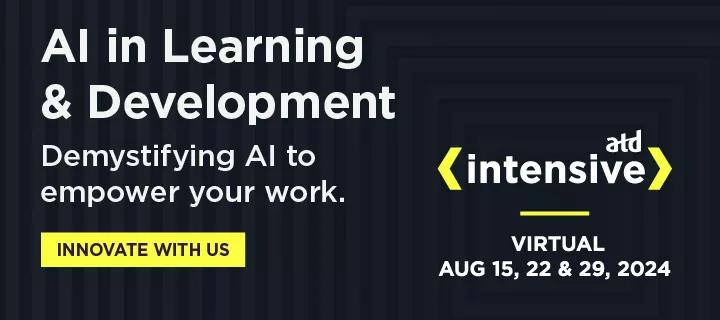ATD Blog
AI-Empowered Teams: Skills Your People Need to Develop and Why
To succeed in an AI-driven workplace, technical and cognitive skills need to join hands. Throwing everything into tools training isn’t enough.
Wed Jul 17 2024

Artificial intelligence (AI) is changing critical, in-demand skills. 64 percent of HR managers agree on this. But how do employees feel about it? Despite early (and understandable) concerns about AI triggering a looming skills gap, employees are now keen to address it. They’re curious about what AI offers them in their current role. They’re also eager to capitalize on the development opportunities linked to frontier technology.
In a recent TalentLMS survey into upskilling and reskilling, half of employees can see the potential of AI to help them with their jobs. 56 percent of workers also believe AI proficiency will enhance their career prospects. And 57 percent agree they should improve their AI skills to stay competitive. Some have even taken matters into their own hands. 39 percent of workers already use AI skills in their roles, and 78 percent of AI users bring their own AI tools to work.
Now is the time for talent development teams to feed this appetite for learning. But how specifically? Providing AI tools training is just part of the story. Developments in generative tech have also brought other skills into focus. Let’s flip through the book to reveal the complete narrative.
Mastering the Use of AI Tools
Fluency in AI tools is clearly at the top of the agenda for employers and HR teams. But businesses are still holding back. Only 41 percent of upskilling and reskilling programs currently provide AI skills training. And, despite 79 percent of leaders agreeing that their company must adopt AI to stay competitive, 59 percent are reluctant to do so. The primary reason? How to demonstrate ROI.
Progressing from ad-hoc experimentation to formally integrating AI into day-to-day workflows requires buy-in from leaders and employees. It also relies on investment in training and resources. In light of AI adoption in the workplace, 54 percent of HR managers see the importance of allocating a budget. But first, they need a clear breakdown of the benefits. Let’s pin them down here.
AI Wins for Employees
According to LinkedIn and Microsoft’s 2024 Work Trend Index Annual Report, 90 percent of AI users agree it saves them time at work. 85 percent say they can focus on adding value where it matters most. 84 percent feel more creative. And 83 percent are happier in their work.
AI tools automate administrative and routine activities, freeing employees up to focus on strategic and creative tasks. Mastering AI technologies also empowers employees to make informed, data-driven decisions. Plus, it enables them to stay ahead of industry trends. Combined, this leads to a better employee experience and higher levels of engagement.
That’s not all.
Beyond the day-to-day workflow, building AI capabilities is also a pathway to more robust career progression. The common consensus among hiring teams and managers is that aptitude in this field is starting to outshine role-specific experience when assessing candidates. This is resonating with employees. 69 percent of those surveyed in the 2024 Work Trend Report believe AI can help them get promoted faster, and 79 percent agree that AI skills will broaden their job opportunities externally.
AI Wins for Employers
As learning professionals and talent development managers know, what’s good for employees is also good for employers. When teams have the skills to leverage AI effectively, improvements in innovation, productivity, and operational efficiency are set to follow. Investing in one of the best LMS systems for AI training also fosters a culture of continuous learning and adaptability. This is crucial for companies striving to maintain a competitive edge and boost employee retention.
Adding to AI Skills: Building Cognitive Strengths
In a new workplace shaped by AI and automation, digital skills have taken center stage. However, optimizing AI takes more than technical know-how. Subsets of soft skills are also grabbing the limelight. Interpersonal and self-management skills are high on the list of employee must-haves. But, 65 percent of HR managers agree that cognitive skills will be most important in an AI-driven future. The top three cognitive skills fall under the following three sub-categories:
1. Problem Solving
Game-changing technology doesn’t come without challenges, and AI is no exception. Yes, it can fly through repetitive tasks, crunch data with ease, and answer multiple questions in an instant. But it generates complexities, too. These cover everything from implementation challenges to issues around governance, ethics, data, and privacy.
Mirroring this dilemma, problem-solving skills received the most votes (within the cognitive skills category) in our survey. Simply put, employees who can analyze potentially overwhelming challenges and offer simple, well-considered solutions will win the race in an AI-led future.
2. Creativity, Originality, and Imagination
The HR managers we surveyed ranked creativity, originality, and imagination second in terms of in-demand cognitive competencies. Grouped together, these three skills empower employees to think in uniquely human ways that counterbalance AI’s machine-led, machine-limited approach. They also enable employees to adapt AI applications in new and innovative ways, thus enhancing AI’s overall value and impact in the workplace.
3. The Ability to Learn
The ability to learn rounds up our list of the top three cognitive skills. It acknowledges the need for employees to nurture an open, agile, and adaptive mindset when working with AI tools. Always a valuable attribute in any employee, the pace at which tech is evolving makes this skill one to nurture now more than ever.
Show the Link and Strike a Balance
To succeed in an AI-driven workplace, technical and cognitive skills need to join hands. Throwing everything into tools training isn’t enough. Employees need to cultivate the right soft skills, too. That way, as technologies evolve, teams will be able to master new applications and, at the same time, overcome new challenges and make the most of new opportunities.
There’s more to it than that, though.
Yes, businesses must design upskilling and reskilling initiatives that reflect that balance. But this two-pronged approach to AI training can’t happen in a vacuum. Learners also need to be clear on the rationale behind the approach and understand how the two sets of competencies support and work together. The result? Higher levels of employee engagement, learning application, and business success.

